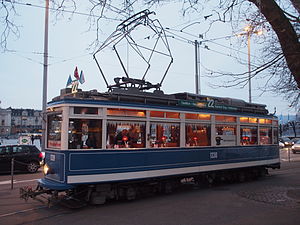VBZ Ce 4/4 (elephant)
| Ce 4/4 "elephant" | |
|---|---|
| Numbering: | Ce 4/4 1301–1350 (until 1947 301–350) (from 1956 Be 4/4 1301–1350) |
| Number: | 50 |
| Manufacturer: |
SWS (wagon construction part) MFO (electrical part) |
| Year of construction (s): | 1929-1931 |
| Retirement: | 1967-1972 |
| Axis formula : | Bo'Bo ' |
| Gauge : | 1000 mm ( meter gauge ) |
| Length over coupling: | 12,360 mm |
| Height: | 3880 mm |
| Width: | 2170 mm |
| Empty mass: | 25.1 t (1301, 1302) 25.5 t (1303–1314) 26.8 t (1315–1350) |
| Hourly output : | 4 × 59 kW = 236 kW |
| Power system : | 600 V DC |
| Power transmission: | Overhead line |
| Operating mode: | Unidirectional locomotive |
| Coupling type: | + GF + |
| Seats: | 25th |
| Standing room: | 35 + 1 |
The VBZ Ce 4/4 "Elefanten" (No. 1301-1350) were the first four-axle railcars of the Zurich tram with the type designation Ce 4/4 (from 1956 Be 4/4). By the transport authorities Zurich (then City tram Zurich ) procured mover carriage were by the nickname " elephant known."
overview
At the end of the 1920s, rush hour traffic in Zurich increased in size, so that the Zurich City Trams (StStZ) were forced to procure powerful vehicles in order to be able to offer three-car trains on the mountain routes. In addition, the decision was made to procure these, the first for Zurich, modular railcars with a single central door on the right-hand side. In the summer of 1929 the first two test cars (301, 302), and then in 1930 the first series (303-314) were delivered. Immediately afterwards, the second series, 1315–1350, was procured in 1930 and 1931. The re-ordering of ten more, planned in 1931, was not carried out. In contrast to the first series, these wagons already had compressed air equipment with an SLM rotary compressor ex works, while the wagons of the first series were delivered with internal shoe brakes (301, 302) or block brakes (303-314). By 1931, cars 301–314 were retrofitted with compressed air brakes. The driver's cab, which was completely separated from the passenger compartment, was also new for Zurich, but it was not until the mid-1950s that it was equipped with foldable seats (similar to a bicycle saddle).
business
Until the arrival of the 65 Ce 4/4 “Kurbeli” and 52 Ce 4/4 “Pedaler” - the so-called Swiss standard wagons - that were procured from 1940 onwards , the Ce 4/4 “elephants” formed the backbone of the tram operation in Zurich. The short and heavy construction with high-speed engines and a gear ratio designed for power - but the maximum speed was only 38 km / h - made it possible to drive three-car trains of 50 t at 25 km / h even on mountain routes with gradients of up to 75 per thousand .
As a rule, the motor vehicles were used with one or two two-axle sidecars. The trailer cars from series 597 - 626 from 1925 and 1926 were preferred, which weighed 6.8 t over a ton more than the two-axle trailer cars built later. In the war and post-war years, four-car trains with three two-axle sidecars were also used on flatter routes. Towards the end of the sixties with the acquisition of the Be 4/6 "Mirage" and the changeover to conductors-free operation, the Ce 4/4 "Elefanten" were retired until 1972 and their mileage was mostly taken over by the Ce 4/4 "Kurbeli".
Location of the vehicles
While all motor vehicles from the first series were broken off, some vehicles from the second series were preserved and are still today as historical vehicles (No. 1321 - again labeled as 321 - and No. 1350) or special vehicles (No. 1330 Partytram ) for events can be rented and used for special trips or on museum line 21 .
gallery
Individual evidence
- ^ A b Walter Trüb, Josef Balen, Peter Kamm: A century of Zurich trams. Orell Füssli Verlag, Zurich 1982, p. 84 ff
- ^ A b Peter Kamm: Zurich Transport 1882-1996. Oberstalden GL 1996, p. 41 and 42
- ↑ Rolling stock . "Aktion Pro Sächsitram" website, accessed February 2, 2014.
- ↑ Special trips . Website Verkehrsbetriebe Stadt Zürich, accessed February 2, 2014.
Remarks
- ↑ When the vehicles were ordered, the number range 401–414 was provided




